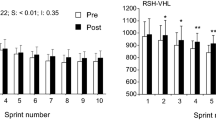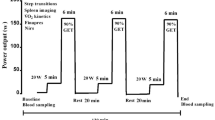Abstract
Purpose
Splenic contraction induced by repeated apneas has been shown to increase oxygen availability. Our aim was to determine whether repeated maximal voluntary apnea enhances the performance of cyclists in a subsequent 4-km time trial.
Methods
Seven male cyclists [age: 27.1 ± 2.1 years; height: 182 ± 8 cm; body mass: 74.8 ± 9.2 kg; peak oxygen uptake: 56.9 ± 6.6 mL min−1 kg−1 (mean ± SD)] performed a 4-km time trial on an ergometer with and without four prior maximal bouts of apnea interspersed with 2 min of recovery.
Results
The average power output during the time trial was similar with (293 ± 48 W) and without (305 ± 42 W) prior apnea (P = 0.11, d = 0.27). The spleen was reduced in size after the fourth bout of apnea (−12.4 ± 9.0 %), as well as one (−36.6 ± 10.3 %) and 10 min (−19.5 ± 17.9 %) after the time trial, while with normal breathing the spleen was smaller one (−35.0 ± 11.3 %) and 10 min (−23.4 ± 19.7 %) after the time trial. Heart rate; oxygen uptake and carbon dioxide production; tissue oxygen saturation; and the lactate concentration, pH, oxygen saturation, level of hemoglobin and hematocrit of the blood were similar under both conditions.
Conclusions
Our present findings reveal that four apneas by cyclists prior to a 4-km time trial led to splenic contraction, but no change in mean power output, the level of hemoglobin, hematocrit, oxygen saturation of the m. vastus lateralis or oxygen uptake.

Similar content being viewed by others
Abbreviations
- ANOVA:
-
Analysis of variance
- Hb:
-
Hemoglobin
- HbO2 :
-
Oxy-hemoglobin
- Hct:
-
Hematocrit
- HHb:
-
Deoxy-hemoglobin
- NIRS:
-
Near-infrared spectroscopy
- pCO2 :
-
Partial pressure of carbon dioxide
- pO2 :
-
Partial pressure of oxygen
- SaO2 :
-
Oxygen saturation
- TSI:
-
Tissue saturation index
- TT:
-
Time trial
- VO2peak :
-
Peak oxygen uptake
- W:
-
Watt
References
Abbiss CR, Laursen PB (2005) Models to explain fatigue during prolonged endurance cycling. Sports Med 35:865–898
Astrand P-O, Rodahl K (1986) Textbook of work physiology :physiological bases of exercise, 3rd edn. McGraw Hill, New York
Bakovic D, Eterovic D, Saratlija-Novakovic Z, Palada I, Valic Z, Bilopavlovic N, Dujic Z (2005) Effect of human splenic contraction on variation in circulating blood cell counts. Clin Exp Pharmacol Physiol 32:944–951. doi:10.1111/j.1440-1681.2005.04289.x
Balestra C, Germonpre P, Poortmans JR, Marroni A (2006) Serum erythropoietin levels in healthy humans after a short period of normobaric and hyperbaric oxygen breathing: the “normobaric oxygen paradox”. J Appl Physiol 100:512–518. doi:10.1152/japplphysiol.00964.2005
Buchheit M, Ufland P (2011) Effect of endurance training on performance and muscle reoxygenation rate during repeated-sprint running. Eur J Appl Physiol 111:293–301. doi:10.1007/s00421-010-1654-9
Buick FJ, Gledhill N, Froese AB, Spriet L, Meyers EC (1980) Effect of induced erythrocythemia on aerobic work capacity. J Appl Physiol: Respir, Environ Exerc Physiol 48:636–642
Chance B, Dait MT, Zhang CD, Hamaoka T, Hagerman F (1992) Recovery from exercise-induced desaturation in the quadriceps muscles of elite competitive rowers. Am J Physiol 262:C766–C775
Cohen D (1988) Statistical power analysis for the behavioral sciences. 2nd (edn) Lawrence Erlbaum Associates, Hillsdale, NJ
Convertino VA (1991) Blood volume: its adaptation to endurance training. Med Sci Sports Exerc 23:1338–1348
de Bruijn R, Richardson M, Schagatay E (2008) Increased erythropoietin concentration after repeated apneas in humans. Eur J Appl Physiol 102:609–613. doi:10.1007/s00421-007-0639-9
Ekblom B, Goldbarg AN, Gullbring B (1972) Response to exercise after blood loss and reinfusion. J Appl Physiol 33:175–180
Espersen K, Frandsen H, Lorentzen T, Kanstrup IL, Christensen NJ (2002) The human spleen as an erythrocyte reservoir in diving-related interventions. J Appl Physiol (1985) 92:2071–2079. doi:10.1152/japplphysiol.00055.2001
Faude O, Kindermann W, Meyer T (2009) Lactate threshold concepts: how valid are they? Sports Med 39:469–490. doi:10.2165/00007256-200939060-00003
Foster GE, Sheel AW (2005) The human diving response, its function, and its control. Scand J Med Sci Sports 15:3–12. doi:10.1111/j.1600-0838.2005.00440.x
Ge RL et al (2002) Determinants of erythropoietin release in response to short-term hypobaric hypoxia. J Appl Physiol (1985) 92:2361–2367. doi:10.1152/japplphysiol.00684.2001
Hamaoka T et al (1996) Noninvasive measures of oxidative metabolism on working human muscles by near-infrared spectroscopy. J Appl Physiol 81:1410–1417
Heinicke K et al (2001) Blood volume and hemoglobin mass in elite athletes of different disciplines. Int J Sports Med 22:504–512. doi:10.1055/s-2001-17613
Heuberger JA et al (2013) Erythropoietin doping in cycling: lack of evidence for efficacy and a negative risk-benefit. Br J Clin Pharmacol 75:1406–1421. doi:10.1111/bcp.12034
Hurford WE, Hong SK, Park YS, Ahn DW, Shiraki K, Mohri M, Zapol WM (1990) Splenic contraction during breath-hold diving in the Korean Ama. J Appl Physiol 69:932–936
Hurford WE et al (1996) Splenic contraction, catecholamine release, and blood volume redistribution during diving in the Weddell seal. J Appl Physiol (1985) 80:298–306
Joulia F, Steinberg JG, Wolff F, Gavarry O, Jammes Y (2002) Reduced oxidative stress and blood lactic acidosis in trained breath-hold human divers. Respir Physiol Neurobiol 133:121–130
Joulia F, Steinberg JG, Faucher M, Jamin T, Ulmer C, Kipson N, Jammes Y (2003) Breath-hold training of humans reduces oxidative stress and blood acidosis after static and dynamic apnea. Respir Physiol Neurobiol 137:19–27
Koga T (1979) Correlation between sectional area of the spleen by ultrasonic tomography and actual volume of the removed spleen. J Clin Ultrasound 7:119–120. doi:10.1002/jcu.1870070208
Lemaitre F, Seifert L, Polin D, Juge J, Tourny-Chollet C, Chollet D (2009) Apnea training effects on swimming coordination. J Strength Cond Res/Natl Strength Cond Assoc 23:1909–1914. doi:10.1519/JSC.0b013e3181b073a8
Marx JJ, Vergouwen PC (1998) Packed-cell volume in elite athletes. Lancet 352:451
Prommer N, Ehrmann U, Schmidt W, Steinacker JM, Radermacher P, Muth CM (2007) Total haemoglobin mass and spleen contraction: a study on competitive apnea divers, non-diving athletes and untrained control subjects. Eur J Appl Physiol 101:753–759. doi:10.1007/s00421-007-0556-y
Richardson M, de Bruijn R, Holmberg HC, Bjorklund G, Haughey H, Schagatay E (2005) Increase of hemoglobin concentration after maximal apneas in divers, skiers, and untrained humans. Can J Appl Physiol 30:276–281
Schagatay E, Andersson JP, Hallen M, Palsson B (2001) Selected contribution: role of spleen emptying in prolonging apneas in humans. J Appl Physiol (1985) 90:1623–1629 (discussion 1606)
Schagatay E, Haughey H, Reimers J (2005) Speed of spleen volume changes evoked by serial apneas. Eur J Appl Physiol 93:447–452. doi:10.1007/s00421-004-1224-0
Schmidt W et al (2002) Blood volume and hemoglobin mass in endurance athletes from moderate altitude. Med Sci Sports Exerc 34:1934–1940. doi:10.1249/01.MSS.0000041225.34124.98
Sperlich B, Born DP, Swaren M, Kilian Y, Geesmann B, Kohl-Bareis M, Holmberg HC (2013) Is leg compression beneficial for alpine skiers? BMC sports sci, med rehabil 5:18. doi:10.1186/2052-1847-5-18
Warburton DE, Gledhill N, Jamnik VK, Krip B, Card N (1999) Induced hypervolemia, cardiac function, VO2max, and performance of elite cyclists. Med Sci Sports Exerc 31:800–808
Wolf M, Ferrari M, Quaresima V (2007) Progress of near-infrared spectroscopy and topography for brain and muscle clinical applications. J Biomed Opt 12:062104. doi:10.1117/1.2804899
Yamada E et al (2005) Vastus lateralis oxygenation and blood volume measured by near-infrared spectroscopy during whole body vibration. Clin Physiol Funct Imaging 25:203–208. doi:10.1111/j.1475-097X.2005.00614.x
Acknowledgments
The authors extend their sincere thanks to Dr. Thomas Streicher for help with the laboratory analyses and to Dr. Christian Keller for technical help.
Conflict of interest
None of the authors has any conflicts of interest to declare.
Author information
Authors and Affiliations
Corresponding author
Additional information
Communicated by Peter Krustrup.
Rights and permissions
About this article
Cite this article
Sperlich, B., Zinner, C., Pfister, R. et al. Repeated apnea-induced contraction of the spleen in cyclists does not enhance performance in a subsequent time-trial. Eur J Appl Physiol 115, 205–212 (2015). https://doi.org/10.1007/s00421-014-3003-x
Received:
Accepted:
Published:
Issue Date:
DOI: https://doi.org/10.1007/s00421-014-3003-x




